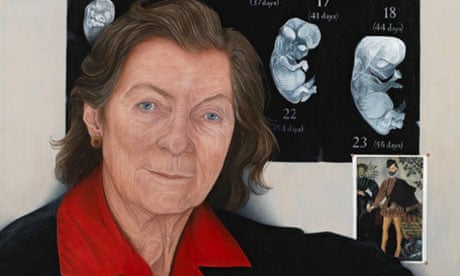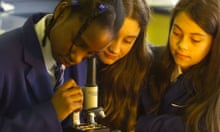Women in science have an image problem. It is not so much deciding whether they should aspire to the hard image of being a scientist or the soft image of being feminine, it is the more serious problem of invisibility. Nowhere is this more obvious than in our august institutions, our imposing portrait galleries and grand museums. There is a dearth of dignified portraits of women scientists produced by distinguished artists.
There are historical reasons for this. In the Royal Society's buildings there are many portraits of great scientists, mainly donated, and many portraits of past presidents, usually commissioned. It is not surprising that there are few portraits of women since women have only been admitted as Fellows since 1945. The exhibition, simply called "Scientists", gives an opportunity to show them off. This exhibition, part of the Royal Society's Summer Science Exhibition and one of the many activities it is undertaking to promote and increase diversity both at the society and within the scientific community, includes loans of works and, for the first time, commissioned drawings.
Preparing for this exhibition made it strikingly clear that there is a void in representations of women in science. We particularly lack them in traditional forms where imaginative thought, sitting sessions and artistic patience is needed to accomplish something more than simply a likeness. But we also lack them in contemporary media, such as inspiring installations or computer art.
Perhaps the time has come to take some steps towards a change. Why should only dead scientists and ex-presidents be represented? Why only older people? It seemed the right moment to commission some drawings of young but already accomplished women scientists. Their presence on the walls of the Royal Society will certainly be an exclusive and hopefully refreshing innovation.
Garry Kennard is an artist who has long been making links between science and art. He undertook to produce the four pen-and-ink portraits shown here, finding subjects in the Royal Society's university research fellows and Rosalind Franklin prizewinners. We hope that the resulting studies are a foretaste of a future where fine art portraits of young scientists are seen more often. We have no idea what a critical mass of portraits of present day scientists would do to our perception of this community, nor do we know what the effects of seeing more portraits of women scientists might be.
What does science say? Do portraits of women have a measurable influence on what people do? Researchers at the University of Neuchatel, Switzerland, pursued this question with an experiment. They asked 149 students to give a political speech in front of a mixed audience in an immersive virtual reality environment. The speakers were randomly assigned one of four rooms in which to give their speech: facing a plain wall, or a wall with the projected image of Bill Clinton, Hillary Clinton, or Angela Merkel. No further reference was made to the portraits.
Previous work suggested that men would speak longer than women in this sort of situation. This was found again in the blank wall condition. But there was a subtle portrait effect and this was found only for the young women. Women talked significantly longer in the presence of the portrait of a female leader.
Interestingly, the presence of a picture of a female leader gave women a distinct boost. The same pattern was found when outside observers had to judge how good the speeches were. In addition, the women speakers themselves evaluated their performance more positively.
As scientists we have to be scrupulous about not over-interpreting results. Even if replicated, the finding does not mean that the mere presence of pictures of women leaders is enough, or even necessary, to boost young women's performance and self-evaluation. There are many other factors that play a role in women's success as leaders.
The presence of portraits of senior women may merely be a "prime", that is, one of many cues present in the environment that unconsciously bias our perception and behaviour in certain directions. The effectiveness of such cues has been amply demonstrated and, conversely, there are cues that act as a "stereotype threat". So, for example, telling girls that boys do better at mathematics, depresses performance on a subsequent maths test.
However, there is also a "stereotype lift", and it may be delivered by portraits of eminent women. Such a lift, however subtle, is very welcome. I hope that at least some visitors to the exhibition will experience it.
Uta Frith is a fellow of the Royal Society and a professor at the Institute of Cognitive Neuroscience and Department of Psychology, University College London




Comments (…)
Sign in or create your Guardian account to join the discussion